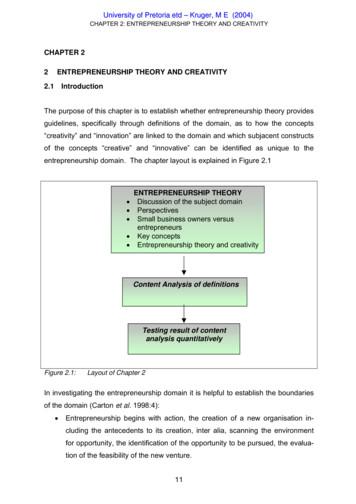A Global Perspective On Entrepreneurship, And Development
Leveraging EntrepreneurialAmbition and Innovation:A Global Perspective on Entrepreneurship,Competitiveness and DevelopmentJanuary 2015
World Economic Forum2015 – All rights reserved.No part of this publication may be reproduced or transmitted in any form or by any means,including photocopying and recording, or by any information storage and retrieval system.BLeveraging Entrepreneurial Ambition and Innovation
Contents1Preface2Executive Summary31. Introduction3461.1 Methodology1.2 Sample Description1.3 Report Structure72. Entrepreneurship and Competitiveness:A Complicated Relationship7121721232.1 Early-stage Entrepreneurial Activity2.2 Ambitious Entrepreneurship2.3 Innovative Entrepreneurship2.4 Summary3. Five Clusters of Entrepreneurial Economies23 3.1 Five Types of EntrepreneurialEconomies28303.2 Understanding the Clusters3.3 The Evolution of EntrepreneurialEconomies334. Conclusion and Implications for Policy34Implications for Entrepreneurship Policy35Appendix37AcknowledgementsPrefaceThe World Economic Forum and Global Entrepreneurship Monitor are pleased torelease Leveraging Entrepreneurial Ambition and Innovation: A Global Perspective onEntrepreneurship, Competitiveness and Development, which examines the relationshipof entrepreneurship and competitiveness from a fresh perspective. The report buildson and advances our extensive previous work on this issue.1By drawing on two unique data sets – the Forum’s Global Competitiveness Index andGlobal Entrepreneurship Monitor’s assessment of entrepreneurial activity – the reporttakes a nuanced stance on the prevalence and types of entrepreneurs globally, andthe environments in which they thrive. Our look at entrepreneurship aims to provide adeeper understanding of early stage entrepreneurial activity by taking into account thatnot all entrepreneurs are the same. Specifically, we highlight early-stage entrepreneursthat are innovative and ambitious about their growth expectations, arguably those withthe highest impact on economies.What we find is thought-provoking: In general, early-stage entrepreneurial activity ishigher in economies that are less competitive and lower in highly competitive economies.Conversely, the proportion of ambitious and innovative entrepreneurs is more frequentlyhigh in more competitive economies. Importantly, we find that in many highly competitive economies with low rates of business starts, entrepreneurial drive manifests itselfthrough more formalized structures – in what we call “entrepreneurial employee activity” –,which should caution anyone from jumping to quick conclusions about the quality ofentrepreneurial ecosystems based on entrepreneurship rates alone.Just two economies in our sample – Colombia and Chile – combine high early-stageentrepreneurial activity with a high proportion of ambitious and innovative entrepreneurs.All other economies fall within the average (or below the average) on at least one of ourthree dimensions and we have grouped similar economies through cluster analysis.We believe those results raise some critical insights for policymakers, first and foremostamongst which is that there is no “cookie-cutter” approach to entrepreneurship policy.Governments need a keen understanding of the specific conditions for entrepreneurs intheir economies to develop successful strategies to support entrepreneurs.This report is the result of collaboration between the World Economic Forum and GlobalEntrepreneurship Monitor, with interviews with entrepreneurs contributed by Endeavor.We will continue to advance the entrepreneurship agenda through our multistakeholderplatform and hope this report stimulates debate around this critical issue. We invitefeedback and look forward to a fruitful discussion.Michael DrexlerSenior DirectorHead of Investor IndustriesWorld Economic ForumMike HerringtonExecutive DirectorGlobal Entrepreneurship Research AssociationGraduate School of BusinessUniversity of Cape Town, South AfricaLeveraging Entrepreneurial Ambition and Innovation1
Executive SummaryThe World Economic Forum is pleased to release LeveragingEntrepreneurial Ambition and Innovation: A Global Perspectiveon Entrepreneurship, Competitiveness and Development, whichexamines the relationship of entrepreneurship and competitivenessfrom a fresh perspective. The report builds on and advances ourextensive previous work on this issue.The study described in this report combines two unique datasets, the World Economic Forum’s Global CompetitivenessIndex data, which ranks the economic competitiveness of 144economies, and Global Entrepreneurship Monitor’s assessmentof entrepreneurial activity across 70 economies. Using five yearsof data from both sets, the study analyses a sample of 44 economies by first examining three aspects of entrepreneurial activity,then grouping economies into five types of entrepreneurialclusters, and finally developing a deeper understanding of eachtype of cluster. Lastly, the study delves into what policymakingbest benefits the unique characteristics of different economies.The three aspects of entrepreneurial activity examined in thestudy are “early-stage entrepreneurial activity” 2, measured asa percentage of the working-age population, the proportion of“ambitious” entrepreneurs (who expect to create 20-plus jobsin 5 years) and the proportion of “innovative” entrepreneurs(who offer new products or services).All three metrics were highly prevalent in only two economies:Colombia and Chile. All other economies fall within the average(or below the average) on at least one of our three dimensions.In general, less competitive economies have greater early-stageentrepreneurial activity than more competitive economies. Conversely, we found that the proportion of ambitious and innovativeentrepreneurs is more frequently high in more competitive economies. More competitive economies also have higher rates ofintrapreneurship, also known as entrepreneurial employee activity.To develop a deeper understanding of how entrepreneurshipinteracts with economic competitiveness, what preconditionsand business strategies drive different combinations of entrepreneurship types and how policymaking can improve theirimpact, the study identified five clusters of economies amongthe 44-country sample:1. All-rounder economies with high rates of early-stage,ambitious and innovative entrepreneurs;2. High-Activity economies with high rates of early-stageentrepreneurial activity, and average or lower ambitionand innovation;3. High-Ambition economies with average or lower ratesof early-stage activity and innovation, but high ambition;4. High-Innovation economies with average or lowerearly-stage activity and ambition and high innovation; and5. Neutral economies with average or lower rates on allthree metrics.2Leveraging Entrepreneurial Ambition and InnovationThe study distils entrepreneurial preconditions to four categories:1) entrepreneurial connections; 2) awareness of opportunities;3) inherent entrepreneurial skills; and 4) a risk-taking culture.High-Activity and All-rounders, accounting for 13 countries inthe sample, possess all of them. In High-Ambition and HighInnovative economies, business strategy matters, especiallyregarding access to foreign markets. The Neutral and Highambition clusters are dominated by highly competitive, mostlyEuropean countries with strong corporate cultures and LatinAmerica is not at all represented. The hidden factor in thisequation is entrepreneurial employee activity. In fact, an inversecorrelation between entrepreneurial employee activity andearly-stage entrepreneurial activity is evident.The three stages of economic development also affect the typesof sectors in which entrepreneurs proliferate, with consumerservices comprising the bulk of entrepreneurial activity in factordriven and most efficiency-driven economies, the latter of whichbegin to move into business services and transforming businessventures. Colombia and Chile are the only economies in theAll-rounders cluster and have aggressive entrepreneurshippolicymaking programs in place.Regarding policymaking, authorities must consider three factors:(1) the type of entrepreneurial economy in which the entrepreneurship policy is being conducted, (2) the specific entrepreneurialoutcome to be achieved, and (3) the levers available to achievea specific outcome.
Section 1IntroductionIt is widely believed that entrepreneurial activity is a critical component to a prosperous society in that entrepreneurs create jobs,drive progress and contribute to economic growth. Consequently,many governments and their policymakers aim to increase thenumber of entrepreneurs in their countries and aid their development. But providing this support is no easy task, as entrepreneursare not homogenous even within a country, and, in fact, oftenappear in different guises depending on the country in whichthey are located.This report examines the concept of entrepreneurship by separating it into three dimensions: 1) early-stage entrepreneurialactivity; 2) growth-oriented, or ambitious, entrepreneurship; and3) innovation-based entrepreneurship. By examining entrepreneurship in such a manner, the study described in this reportpeers beneath the surface of entrepreneurial activity to develop auseful framework for policymakers to understand and breed theentrepreneurs that benefit societies, and, importantly, the uniquesocieties in which they operate. Regarding the latter, designingentrepreneurship policy will often vary by country. Accordingly,this study will show that entrepreneurship is highly contextual to aunique economy and requires deep understanding of contextualeffects for policymakers to achieve intended outcomes.The report builds on, and advances, prior work of academics,organizations and their programs, such as Endeavor, the GlobalEntrepreneurship Program of the U.S. State Department, aswell as the Forum’s previous work in partnership with EY andEndeavor on high-impact entrepreneurs and their trajectories.31.1 MethodologyWhile seemingly intuitive that an economy’s competitiveenvironment has an impact on entrepreneurs, and that, viceversa, entrepreneurs impact and contribute to an economy’scompetitiveness, the relationship is more complex than it seems.Drawing from the Forum’s own Global Competitiveness Index(GCI) and Global Entrepreneurship Monitor (GEM) Adult Population Survey, this report summarizes findings from analysingassociations between the competitiveness of economies andthe nature of entrepreneurs in those economies, and drawsattention to possible avenues for further research with this data.To maximize the robustness of the findings from the two datasets, the study averages the aggregate GCI scores for competitiveness from the 2008/09 through 2013/14 surveys andaverages GEM’s annual entrepreneurship data from its 2009through 2013 surveys.Global Competitiveness Index (GCI)The Global Competitiveness Index (GCI) assesses competitiveness in 144 economies, providing insight into their productivitydrivers. The GCI is the most comprehensive worldwide assessment of national competitiveness, providing a platform for dialogue between government, business and civil society regardingthe actions required to improve economic prosperity. Competitiveness in the GCI is defined as the set of institutions, policies andfactors that determine the level of productivity of a country. Thelevel of productivity, in turn, determines the level of prosperity thatcan be attained in an economy. The index captures the differentaspects of competitiveness in 12 pillars. Each of these pillarsare scored on a scale of 1 to 7, 7 being the most competitive.This report averages the scores of each country from 2008/09to 2013/2014.Leveraging Entrepreneurial Ambition and Innovation3
IntroductionGlobal Entrepreneurship Monitor (GEM)Development StagesThe Global Entrepreneurship Monitor (GEM) is the largest ongoingannual study of entrepreneurial activity in the world, exploring therole of entrepreneurship in economic growth within nations byunveiling detailed national features and characteristics associatedwith their entrepreneurial activity. Initiated in 1999 as a partnership between London Business School and Babson College, thefirst study covered 10 countries; since then, nearly 100 “nationalteams” worldwide have participated in the research. The nationalteams oversee annual surveys of at least 2,000 adults (18-64years of age) in their respective countries, assessing the rate andprofile of entrepreneurship, the motivations and aspirations ofentrepreneurs and social attitudes toward entrepreneurial activity.The data collected overseen is by a central team of experts whoguarantee its quality and “harmonize” it to facilitate cross-nationalcomparisons. With its focus on individuals, GEM offers a lens toview the people who participate in entrepreneurship at all phasesof the entrepreneurial process. Additionally, unlike studies focusing on business registrations, GEM captures both informal andformal entrepreneurship and both new business creation activityand entrepreneurial employee activity. In less competitive economies, a substantial portion of entrepreneurial activity is represented in the informal sector, while entrepreneurial employee activityis more significant in more competitive economies.In line with widely accepted economic theory regarding the threestages of economic development, the GCI assumes that in thefirst stage of development, the economy is “factor-driven” andcountries compete based upon their factor endowments, whichare primarily unskilled labour and natural resources. Companiescompete on the basis of price and sell basic products (e.g. commodities), and low wages reflect low productivity. Maintainingcompetitiveness at this stage of development hinges primarily onwell-functioning public and private institutions, well-developedinfrastructure, stable macroeconomic environments, and healthyworkforces with basic education.1.2 Sample DescriptionThe analysis in this report is based on a sample of 44 economies(see Figure 1.2.1), merging the GCI and GEM data sets. Table1.2.1 lists the countries in the study’s sample by region anddevelopment level. The economies chosen were those for whichdata was available from the GCI over the study period of 20092013 and for which GEM data was available for at least 4 of the5 years of this study period. Economies of countries in each ofthe three main economic development stages as defined by theGCI are represented.Figure 1.2.1 Map of economies in sample4Leveraging Entrepreneurial Ambition and InnovationAs a country becomes more economically competitive, its productivity and wages increase, moving into an “efficiency-driven”stage of development. Companies in these economies developefficient production processes and increase product quality tomaintain competitiveness and avoid passing labour costs ontopricing. These countries have large domestic markets, or access to foreign markets, and harness existing technologies andimproved higher education and training and leverage efficientgoods, well-functioning labor (Pillar 7) and developed financialmarkets. In efficiency-driven economies, governments focus (orshould focus) on ensuring smooth mechanisms, such as theproper functioning and development of the previously mentionedmarkets, higher education systems and technology infrastructure.Finally, as countries enter the “innovation-driven” stage, higherwages and the requisite standard of living are sustainable onlywhen businesses can compete with sophisticated productionprocesses and innovative products. In these economies, highlabour costs cause innovation to be more important levers ofeconomic development than efficiency enhancers.4
IntroductionTable 1.2.1: Economies by development level and geographic venAsia Pacific & South AsiaMalaysia, ChinaJapan, Korea, TaiwanEuropean UnionCroatia, Hungary, Latvia,RomaniaBelgium, Denmark, FinlandFrance, Germany, Greece,Ireland, Italy, Netherlands,Portugal, Slovenia, Spain,Sweden, UKLatin America & CaribbeanArgentina, Brazil, Chile, Colombia,Ecuador, Guatemala, Jamaica,Mexico, Panama, Peru, UruguayTrinidad & TobagoMiddle East & North AfricaAlgeriaIsraelBosnia and Herzegovina, RussiaNon-European UnionSub-Saharan AfricaNorway, SwitzerlandUnited StatesNorth AmericaUgandaSouth AfricaThe 44 countries in this sample cover the range of economiccompetitiveness as assessed by the GCI. Switzerland is themost competitive country in the sample as well as being themost competitive country in the overall survey of 144 countriesin the 2014/15 GCI. Uganda is the least competitive country inthis study, ranking 122nd of 144 economies in the 2014/15 GCI.Overall, the sample in this report’s study is more competitive thanthe universe of 144 countries in the GCI. While the median competitiveness score in the GCI universe is 4.2, the median scorefor the 44-country sample for this study is 4.4. Less than 5% ofthe countries in the sample score below 4, compared with 38%in the full GCI universe.For the purpose of this report only, economies are separated intothree groups: “high competitiveness”, which comprise countrieswith overall scores of 5 and above; “moderate competitiveness”for scores of 4 to 5; and “low competitiveness” for scores below4 (see Figure 1.2.2).Figure 1.2.2: Competitiveness mapHigh competitivenessModerate competitivenessLow competitivenessLeveraging Entrepreneurial Ambition and Innovation5
IntroductionThe majority (15 out of 20) of efficiency-driven countries in thesample are moderately competitive, with five in the low competitive stage of development. Both factor-driven countries in thestudy’s sample are low competitive.Figure 1.2.3 shows how the development stages (see “Development Stages” Box) and range of competitiveness of the economies of the 44 countries translate into this study’s unique competitiveness scores. All 14 highly competitive economies in thestudy’s 44-country sample are also innovation-driven economieswhile among the remaining eight innovation-driven economies,six are moderately competitive and two low competitive.Switzerland is the most competitive country in the sample, with ascore of 5.66. The least competitive of the 22 innovation-driveneconomies is Trinidad and Tobago with a score of 3.94. Malaysiais the most competitive of the efficiency-driven countries, fallingjust short of being grouped with the highly competitive countries,with a score of 4.99. At 3.7, Bosnia and Herzegovina is the leastcompetitive efficiency-driven country. Factor-driven countriesUganda and Algeria have GCI scores of 3.48 and 3.84(see figure 1.2.4).Figure 1.2.3: Competitiveness by development level(number of economies)25201415151.3 Report StructureHigh10The report is structured as follows: In Section 2, it introduces thethree dimensions of entrepreneurship, showing how they are distributed across the study’s sample of 44 countries, and examinesthe correlations of these dimensions to competitiveness rankings.In Section 3, the report clusters the countries into five distincttypes of entrepreneurship profiles and develops a framework tounderstand their unique entrepreneurial context. Lastly, in Section4, the study draws conclusions and discusses policy implications.Interviews with entrepreneurs are dispersed throughout the reportto underline the analysis with the entrepreneurial drivenEfficiency-driven20Figure 1.2.4: Competitiveness by e5.505.004.504.003.50Leveraging Entrepreneurial Ambition and InnovationSwedenSwitzerlandFinlandUnited StatesGermanyJapanNetherlandsDenmarkUnited KingdomNorwayTaiwan, ChinaFranceBelgiumKorea, alySloveniaSouth AfricaBrazilPanamaHungaryLatviaMexicoRussian uatemalaTrini
The World Economic Forum and Global Entrepreneurship Monitor are pleased to release Leveraging Entrepreneurial Ambition and Innovation: A Global Perspective on Entrepreneurship, Competitiveness and Development, which examines the relationship of entrepreneurship and competitiveness fro
To define the entrepreneurship. To explain the significance of Entrepreneurship. To explain the Entrepreneurship Development. To describe the Dynamics of Entrepreneurship Development. 1.1 Need and significance of Entrepreneurship Development in Global contexts It is said that an economy is an effect for which entrepreneurship is the cause.
This is "Global Entrepreneurship and Intrapreneurship", chapter 11 from the bookChallenges and Opportunities in International Business(index.html)(v. 1.0). . Who is an entrepreneur, and what is entrepreneurship? 2. What do entrepreneurs do? 3. What is entrepreneurship across borders? 4. How does entrepreneurship lead to global start-ups?
Global Entrepreneurship Education II- FRAMEWORK TABLE 1: CASES BY LEARNER CATEGORY III- ENTREPRENEURSHIP EDUCATION IN CHINA The Maker Space of Tsinghua University High School: Extreme Learning Process (XLP) For Entrepreneurship Education Tsinghua x-lab: a University-based Platform For Creativity, Innovation and Entrepreneurship Education
1. Teaching with a Multiple-Perspective Approach 8 . 2. Description of Perspectives and Classroom Applications 9 . 2.1 Scientific Perspective 9 . 2.2 Historical Perspective 10 . 2.3 Geographic Perspective 11 . 2.4 Human Rights Perspective 12 . 2.5 Gender Equality Perspective 13 . 2.6 Values Perspective 15 . 2.7 Cultural Diversity Perspective 16
ENTREPRENEURSHIP EIGHTH EDITION ROBERT D. HISRICH.PhD Garvin Professor of Global Entrepreneurship Director, Walker Center for Global Entrepreneurship Thunderbird School of Global Management MICHAEL P. PETERS, PhD Professor Emeritus Carroll School of Management Boston College DEAN A. SHEPHERD, PhD Randall L. Tobias Chair in Entrepreneurial .
CHAPTER 2: ENTREPRENEURSHIP THEORY AND CREATIVITY ctives. epreneurs. reneurship. 3:49). thought on the meaning of entrepreneurship. One group focused on the characteris-tics of entrepreneurship (e.g. innovation, growth, uniqueness) while a second group focused on the outcomes of entrepreneurship (e.g. the creation of value).
identify and describe characterizations of technology entrepreneurship, digital techno-logy entrepreneurship, and digital entrepreneurship. With this new delineation of terms, we would like to foster discussion between researchers, entrepreneurs, and policy makers on the impact of digitization on entrepreneurship, and set a future research agenda.
Academic writing introductions tips with useful phrases Start the introduction by answering the question which you have been set or you have set yourself (“I believe that the government’s policy on ” etc). Start the introduction by setting out the background to the question that you have been set or have set yourself (“In our globalised society, ”, “Over the last few years .






















